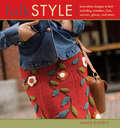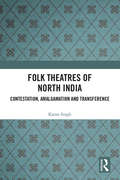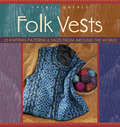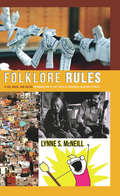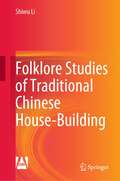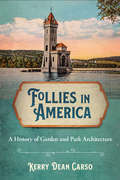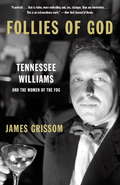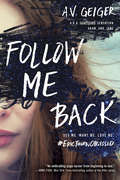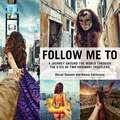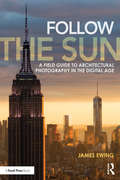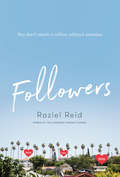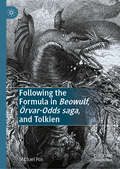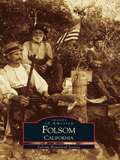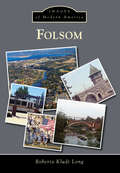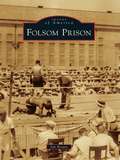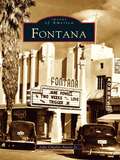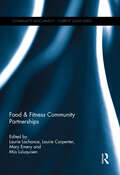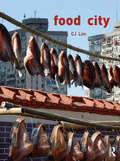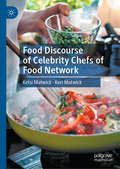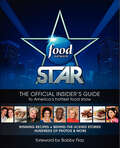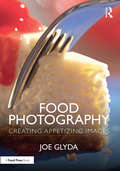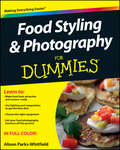- Table View
- List View
Folk Style: Innovative Designs To Knit, Including Sweaters, Hats, Scarves, Gloves, And More (Style Ser.)
by Mags KandisThe unique cultural patterns contained in this lively collection will inspire knitters looking for such bright, new projects as Mexican floor pillows, Shibori neck wraps, Asian cropped vests, and Peruvian tunics. Featuring fashionable items for women, children, babies, and the home, this guide shares techniques on colors, motifs, details, and styles. The vibrant photos and step-by-step directions give beginning and advanced knitters alike the keys to creating colorful, ethnically diverse crafts.
Folk Theatres of North India: Contestation, Amalgamation and Transference
by Karan SinghThis book examines folk theatres of North India as a unique performative structure, a counter stream to the postulations of Sanskrit and Western realistic theatre. In focusing on their historical, social and cultural imprints, it explores how these theatres challenge the linearity of cultural history and subvert cultural hegemony. The book looks at diverse forms of theatre such as svangs, nautanki, tamasha, all with conventions like open performative space, free mingling of spectators and actors, flexibility in roles and genres, etc. It discusses the genesis, history and the independent trajectory of folk theatres; folk theatre and Sanskrit dramaturgy; cinematic legacy; and theatrical space as performance besides investigating causes, inter-relations within socio-cultural factors, and the performance principles underlying them. It shows how these theatres effectively contest delimitation of human creative impulses (as revealed in classical Sanskrit theatre) from structuring as also of normative impulses of religion and culture, while amalgamating influences from Western theatre, newly-rising religious reform movements of 19th century India, tantra and Bhakti. It further highlights their ability to adapt and reinvent themselves in accordance with spatial and temporal transformations to constitute an important anthropological layer of Indian society. Comprehensive and empirically rich, this book will be an essential read for scholars and researchers of cultural studies, theatre, film and performance studies, sociology, political studies, popular culture, and South Asian studies.
Folk Vests: 25 Knitting Patterns And Tales From Around The World (Folk Knitting Ser.)
by Cheryl OberleKnitters will delight in these 25 traditional and innovative vest patterns collected from around the world and through the ages. Both functional and decorative, these wonderful projects for men's and women's vests are accompanied by folk stories and regional histories from the country of the design's origin, including Tibet, Scandinavia, Guatemala, Japan, North America, and many others. More than a pattern book, readers will feel connected to the cultures behind the projects as they bring these native crafts to life.
Folklore Rising: An Artist's Journey through the British Ritual Year
by Ben EdgeBen Edge is a rising star of both the art world and the current folk renaissance. This first trade book of Edge's art, featuring over 200 artworks, is a unique insight into his creative process as well as the first mainstream book to explore the amazing and wildly popular folk customs of the British ritual year.'In his deeply squirrelly, edgy, almost mystic paintings, Ben Edge tries to ask where we all come from and why we tell ourselves the stories we tell ourselves.' – Jerry Saltz'It's time to rediscover the real and this book tells you where to find it. Indispensable.' – Jarvis CockerBen Edge has travelled the length and breadth of Britain recording the weird and wonderful folk customs alive in communities all over the country. In this book, the first trade edition of his art, he shares over 200 paintings and photographs, along with real-life stories, anecdotes and legends. He talks about how connecting with our incredible living folklore helped him recover from depression, and also introduces his idea of folklore activism, suggesting that the current massive resurgence of interest in contemporary folk culture represents ordinary people&’s desire to find new ways of envisioning community and caring for and connecting to nature. Readers will be enchanted and inspired by the images and description of:Mass events that are attended by thousands such as the solstices at Stonehenge, the Padstow &‘Obby &‘Oss parade, the Burry Man&’s Day and the Straw Bear of Whittlesea.Practices to celebrate the turning wheel of the year, from wassailing to May Day fertility rites to fire festivals to Mumming Plays.The progressive all-female Morris dancing side Boss Morris.The Green Man – how this has become an icon of modern spirituality and eco-consciousness and a personal symbol of mental health recovery to Ben.Standing stones and the mythology surrounding them.Overall the book explores the psyche of British folklore, showing how this has fed into his art and what this means in the context of contemporary life. It's a book about reconnection with nature, each other and the past through art and folklore.
Folklore Rules: A Fun, Quick, and Useful Introduction to the Field of Academic Folklore Studies
by Lynne S. McNeillFolklore Rules is a brief introduction to the foundational concepts in folklore studies for beginning students. Designed to give essential background on the current study of folklore and some of the basic concepts and questions used when analyzing folklore, this short, coherent, and approachable handbook is divided into five chapters: What Is Folklore?; What Do Folklorists Do?; Types of Folklore; Types of Folk Groups; and, finally, What Do I Do Now? Through these chapters students are guided toward a working understanding of the field, learn basic terms and techniques, and learn to perceive the knowledge base and discourse frame for materials used in folklore courses. Folklore Rules will appeal to instructors and students for a variety of courses, including introductory folklore and comparative studies as well as literature, anthropology, and composition classes that include a folklore component.
Folklore Studies of Traditional Chinese House-Building
by Shiwu LiThis book provides extensive information on craftsmen-built houses in China. Though some inroads have been made in studying this folk custom, this work represents the first comprehensive and systematic monograph. The book examines the topic at the two main levels of “history” and “theory”. Combining historical textual research, contemporary textual research, and field study, the book presents systematic information on the folk custom of craftsmen-built houses in China. At the level of theoretical research, it puts forward some original opinions on the major theoretical issues, such as the folk custom of religious belief, the boundary between superstition and religion, and the relationship between oral literature and ritual. The book provides a guide to help readers systematically understand the folk custom of craftsmen-built houses in China. Sharing valuable insights into Chinese architectural history, as well as religious studies, cultural anthropology, and folklore, it will appeal to researchers in the fields of folklore, cultural anthropology, and architecture and can also serve as a popular science book for understanding Chinese architectural culture.
Follies in America: A History of Garden and Park Architecture
by Kerry Dean CarsoFollies in America examines historicized garden buildings, known as "follies," from the nation's founding through the American centennial celebration in 1876. In a period of increasing nationalism, follies—such as temples, summerhouses, towers, and ruins—brought a range of European architectural styles to the United States. By imprinting the land with symbols of European culture, landscape gardeners brought their idea of civilization to the American wilderness.Kerry Dean Carso's interdisciplinary approach in Follies in America examines both buildings and their counterparts in literature and art, demonstrating that follies provide a window into major themes in nineteenth-century American culture, including tensions between Jeffersonian agrarianism and urban life, the ascendancy of middle-class tourism, and gentility and social class aspirations.
Follies of God
by James GrissomAn extraordinary book; one that almost magically makes clear how Tennessee Williams wrote; how he came to his visions of Amanda Wingfield, his Blanche DuBois, Stella Kowalski, Alma Winemiller, Lady Torrance, and the other characters of his plays that transformed the American theater of the mid-twentieth century; a book that does, from the inside, the almost impossible--revealing the heart and soul of artistic inspiration and the unwitting collaboration between playwright and actress, playwright and director.At a moment in the life of Tennessee Williams when he felt he had been relegated to a "lower artery of the theatrical heart," when critics were proclaiming that his work had been overrated, he summoned to New Orleans a hopeful twenty-year-old writer, James Grissom, who had written an unsolicited letter to the great playwright asking for advice. After a long, intense conversation, Williams sent Grissom on a journey on the playwright's behalf to find out if he, Tennessee Williams, or his work, had mattered to those who had so deeply mattered to him, those who had led him to what he called the blank page, "the pale judgment." Among the more than seventy giants of American theater and film Grissom sought out, chief among them the women who came to Williams out of the fog: Lillian Gish, tiny and alabaster white, with enormous, lovely, empty eyes ("When I first imagined a woman at the center of my fantasia, I . . . saw the pure and buoyant face of Lillian Gish. . . . [She] was the escort who brought me to Blanche") . . . Maureen Stapleton, his Serafina of The Rose Tattoo, a shy, fat little girl from Troy, New York, who grew up with abandoned women and sad hopes and whose job it was to cheer everyone up, goad them into going to the movies, urge them to bake a cake and have a party. ("Tennessee and I truly loved each other," said Stapleton, "we were bound by our love of the theater and movies and movie stars and comedy. And we were bound to each other particularly by our mothers: the way they raised us; the things they could never say . . . The dreaming nature, most of all") . . . Jessica Tandy ("The moment I read [Portrait of a Madonna]," said Tandy, "my life began. I was, for the first time . . . unafraid to be ruthless in order to get something I wanted") . . . Kim Stanley . . . Bette Davis . . . Katharine Hepburn . . . Jo Van Fleet . . . Rosemary Harris . . . Eva Le Gallienne ("She was a stone against which I could rub my talent and feel that it became sharper") . . . Julie Harris . . . Geraldine Page ("A titanic talent") . . . And the men who mattered and helped with his creations, including Elia Kazan, José Quintero, Marlon Brando, John Gielgud . . . James Grissom's Follies of God is a revelation, a book that moves and inspires and uncannily catches that illusive "dreaming nature."From the Hardcover edition.
Follies of God: Tennessee Williams and the Women of the Fog
by James GrissomAn extraordinary book; one that almost magically makes clear how Tennessee Williams wrote; how he came to his visions of Amanda Wingfield, his Blanche DuBois, Stella Kowalski, Alma Winemiller, Lady Torrance, and the other characters of his plays that transformed the American theater of the mid-twentieth century; a book that does, from the inside, the almost impossible--revealing the heart and soul of artistic inspiration and the unwitting collaboration between playwright and actress, playwright and director.At a moment in the life of Tennessee Williams when he felt he had been relegated to a "lower artery of the theatrical heart," when critics were proclaiming that his work had been overrated, he summoned to New Orleans a hopeful twenty-year-old writer, James Grissom, who had written an unsolicited letter to the great playwright asking for advice. After a long, intense conversation, Williams sent Grissom on a journey on the playwright's behalf to find out if he, Tennessee Williams, or his work, had mattered to those who had so deeply mattered to him, those who had led him to what he called the blank page, "the pale judgment." Among the more than seventy giants of American theater and film Grissom sought out, chief among them the women who came to Williams out of the fog: Lillian Gish, tiny and alabaster white, with enormous, lovely, empty eyes ("When I first imagined a woman at the center of my fantasia, I . . . saw the pure and buoyant face of Lillian Gish. . . . [She] was the escort who brought me to Blanche") . . . Maureen Stapleton, his Serafina of The Rose Tattoo, a shy, fat little girl from Troy, New York, who grew up with abandoned women and sad hopes and whose job it was to cheer everyone up, goad them into going to the movies, urge them to bake a cake and have a party. ("Tennessee and I truly loved each other," said Stapleton, "we were bound by our love of the theater and movies and movie stars and comedy. And we were bound to each other particularly by our mothers: the way they raised us; the things they could never say . . . The dreaming nature, most of all") . . . Jessica Tandy ("The moment I read [Portrait of a Madonna]," said Tandy, "my life began. I was, for the first time . . . unafraid to be ruthless in order to get something I wanted") . . . Kim Stanley . . . Bette Davis . . . Katharine Hepburn . . . Jo Van Fleet . . . Rosemary Harris . . . Eva Le Gallienne ("She was a stone against which I could rub my talent and feel that it became sharper") . . . Julie Harris . . . Geraldine Page ("A titanic talent") . . . And the men who mattered and helped with his creations, including Elia Kazan, José Quintero, Marlon Brando, John Gielgud . . . James Grissom's Follies of God is a revelation, a book that moves and inspires and uncannily catches that illusive "dreaming nature."
Follow Me Back
by A. V. Geiger"Follow Me Back is the perfect mix of fandom with just the right amount of suspense. An enthralling page turner from beginning to end." —Anna Todd, New York Times bestselling author of the After seriesTessa Hart's world feels very small. Confined to her bedroom with agoraphobia, her one escape is the online fandom for pop sensation Eric Thorn. When he tweets to his fans, it's like his speaking directly to her...Eric Thorn is frightened by his obsessive fans. They take their devotion way too far. It doesn't help that his PR team keeps posting to encourage their fantasies. When a fellow pop star is murdered at the hands of a fan, Eric knows he has to do something to shatter his online image fast—like take down one of his top Twitter followers. But Eric's plan to troll @TessaHeartsEric unexpectedly evolves into an online relationship deeper than either could have imagined. And when the two arrange to meet IRL, what should have made for the world's best episode of Catfish takes a deadly turn...Told through tweets, direct messages, and police transcripts, this thriller for the online generation will keep you guessing right up to the shocking end.
Follow Me To: A Journey around the World Through the Eyes of Two Ordinary Travelers
by Nataly Zakharova Murad OsmannThe Follow Me project was created in 2012 based on the concept of showing the beauty and uniqueness of different locations around the world. It is a story told through the eyes of two ordinary travelers who attempt to portray local lifestyles and narratives by means of photography. Since the project's launch on Instagram, it has become a worldwide Internet sensation, emerging as a leading news feature and gathering millions of views on social media and the news sites that covered it. In each stunning image, photographer Murad Osmann is led to a new location by his girlfriend, Nataly Zakharova.These images remind us that in the hustle and bustle of daily life, we so often forget to stop and appreciate the things that surround us--the historical and architectural heritage left to us by our ancestors. Readers join Osmann from the point of view of the main character and are taken on a journey to different historical and cultural sites. The project aims to acquaint readers with different lifestyles. For Osmann and Zakharova, this theme seems infinite, as there are an endless number of places to visit on our planet. Paging through the book, readers will be invited to see something familiar to them from another point of view, via the lens of Osmann's camera.Follow Zakharova and Osmann on a trip around the world, through such locations as Moscow, Madrid, Ibiza, Hong Kong, New York, and London.
Follow the Sun: A Field Guide to Architectural Photography in the Digital Age
by James EwingFollow the Sun will guide you through all aspects of architectural photography, from the genre’s rich history to the exciting new approaches brought by the advent of the digital age. It explains how to use the powerful tools of digital photography while employing many of the skills and traditions of the established genre. Written to be accessible to professionals, amateurs, and students alike, this book will be useful for photographers exploring architecture as fine artists, on editorial assignments, or on commercial shoots. Key features include: • Example photographs and diagrams • Historical background of architectural photography • Advice on essential equipment • How to plan a shoot to your advantage • How to use tilt-shift lenses for architecture • Editing workflow and strategies • Interviews with architectural photographers Peter Aaron, Magda Biernat, Ty Cole, and Elizabeth Felicella.
Followers
by Raziel ReidA naïve teenager is thrown into the high-stakes, back-stabbing world of reality television in this gossipy, satirical romp, perfect for fans of reality TV.After a disastrous date results in her arrest, sixteen-year-old Lily Rhode is horrified to discover her mugshot is leaked on a gossip website. Lily is the niece of Whitney Paley, a Hollywood housewife and star of reality show Platinum Triangle, a soap-opera-style docu-series in the vein of Real Housewives of Beverly Hills and The Hills, revolving around several glamorous families living in the Beverly Hills, Bel Air and Holmby Hills neighborhoods of Los Angeles. When Lily's mom kicks her out of their trailer home in the Valley, Whitney (Lily's mom's estranged sister) invites her to live with her, her movie-star husband, Patrick, and their daughter, Hailey. Lily is set up in the pool house and thrust into the company of reality-star offspring -- kids who are born with silver spoon emojis on their feed. Lily's cousin Hailey and the other teens have lived their entire lives on camera and are masters of deception, with Hailey leading the pack. As Lily learns from the Paleys how to navigate her newfound fame, she finds herself ensnared in the unfolding storylines. What Lily doesn't know is that she's just a pawn being used on the show to make the Paleys look sympathetic to viewers while distracting from on-set sexual misconduct rumors surrounding super hero dad Patrick Paley . . . Is Lily safe under Patrick's roof? Or will Lily be Patrick's downfall? If she isn't destroyed by Hailey first. When Lily catches the eye of Hailey's designated leading man Joel Strom -- it's war!
Following the Comedy Trail
by Leon SmithDetective Leon Smith, a 30-year veteran of the Los Angeles Police Department, guides us on a nostalgic journey to famous LAUREL AND HARDY and OUR GANG movie locations, as well as other famous Hollywood film locations. His investigations reveal exact addresses of these historical sites and feature his present-day photographs along with production stills showing how the locations appeared in the original film. "I LOVE THESE BOOKS! AND I'LL BET THAT ANYONE WHO CARES ABOUT LAUREL AND HARDY, OUR GANG AND HOLLYWOOD HISTORY WILL FEEL THE SAME WAY." Leonard Maltin"LEON SMITH'S JOURNEY BACK TO THE SITES OF MANY OF THE EPISODES IN THE LAUREL AND HARDY AND OUR GANG CANON IS AN EXTENSION OF A PROFESSIONAL CURIOSITY INTO THE KNOWLEDGE THAT THE FACT OF PLACE EVOKES THE MEMORY OF EXPERIENCE. IN THE CASE OF 'FOLLOWING THE COMEDY TRAIL' THE RECOLLECTION IS OF SHEER PLEASURE." Lawrence Christon The Los Angeles Times "NOW THIS IS A GORGEOUS LABOR OF LOVE, RICH WITH PHOTOGRAPHS OF THE SITES AS THEY NOW APPEAR..." Don Thompson, Editor Movie Collector's World
Following the Formula in Beowulf, Örvar-Odds saga, and Tolkien
by Michael FoxFollowing the Formula in Beowulf, Örvar-Odds saga, and Tolkien proposes that Beowulf was composed according to a formula. Michael Fox imagines the process that generated the poem and provides a model for reading it, extending this model to investigate formula in a half-line, a fitt, a digression, and a story-pattern or folktale, including the Old-Norse Icelandic Örvar-Odds saga. Fox also explores how J. R. R. Tolkien used the same formula to write Sellic Spell and The Hobbit. This investigation uncovers relationships between oral and literate composition, between mechanistic composition and author, and between listening and reading audiences, arguing for a contemporary relevance for Beowulf in thinking about the creative process.
Folsom
by Folsom Historical SocietyWith the nearby discovery of gold in 1848, Folsom, which began as a remote camp for trappers and traders, quicklybecame a prosperous mining town in the foothills of the Sierra Mountains. When the railroad arrived, Folsom boomed, serving as a transportation hub and gateway to the gold country. Downtown's Sutter Street became a busy center for merchants, hotels, and commerce, as well as the terminus for the Pony Express. Encompassing 135 years, this book celebrates Folsom's diverse heritage from its beginnings as "Granite City" to the recent growth attributed to the influx of high-tech corporations. Over two hundred images illustrate its history, including personal glimpses of family and home life, churches, schools, holiday celebrations, local culture, politics, and social organizations, to photographs of well-known landmarks and institutions such as the Cohn House, Sutter Street, the Folsom Powerhouse, the railroad, and of course, the infamous Folsom Prison.
Folsom
by Roberta Kludt LongModern Folsom really began in the 1960s. Folsom was a planned town from the beginning in 1856 and initially had housing and businesses for workers at the Sacramento Valley Railroad depot, turntable, and maintenance shops. During the remaining decades of the 19th century to the mid-20th century, Folsom's fortunes fluctuated as it served as a hub for gold recovery, the railroad, Folsom Prison, hydropower, and agriculture. Folsom residents incorporated their town in 1946. Anticipating the changes that would come with construction of a large dam on their border, they wanted local control. From the 1960s to the present, Folsom's story continues as a tale about its people. Their dedication has revitalized the historic district, brought innovative employment, created arts and entertainment centers, and provided high-quality education, civic services, and exceptional recreation choices. Many of them contributed photographs and text to this book.
Folsom Prison (Images of America)
by Jim BrownFolsom Prison is California's second-oldest prison, dating back to 1880. In the decades following the Gold Rush, it housed some of the state's most notorious prisoners in stone, dungeon-like cells behind solid-metal doors; was the first prison with electric power; and for many years provided labor for various state projects, including construction, fabrication, and printing of license plates. Thrust into the public consciousness in the 1960s by high-profile performances from country music's Johnny Cash, the prison remains a notorious and legendary institution. The variety of offenders housed at Folsom are incarcerated for a large gamut of criminal behavior, and the California Department of Corrections has been dedicated to rehabilitation efforts throughout the facility's long history.
Fontana
by John Charles Anicic Jr.The self-proclaimed "City of Innovation" has a great tradition of reinventing itself. Today's Fontana was once known as "Rancho de San Bernardino." The first recorded owner, Don Antonia Maria Lugo, passed the land down to his sons, and in 1851, the Lugo brothers sold their stake to Mormon settlers, who soon relocated to Utah. Various agricultural developers, including A.B. Miller, saw potential in the land, changing its name to "Fontana" from its earlier railroad name "Rosena." But citrus and grain were not the main exports for long. During World War II, the city switched gears to become an industrial powerhouse as Southern California's leading steel producer. At the junction of Interstates 10 and 15, modern Fontana is a vital nexus of transportation and commerce, with the legendary Route 66 passing through its well-preserved downtown district and Route 99 through its southern boundary.
Food & Fitness Community Partnerships (Community Development – Current Issues Series)
by Laurie Lachance, Laurie Carpenter, Mary Emery and Mia LuluquisenThis book describes many of the unique contributions of the Food & Fitness program including a number of early successes, drawing lessons from efforts to form and maintain partnerships, and from the strategies employed to create structural change in communities. This important study introduces the Food and Fitness community partnerships and their work to increase access to healthy, locally grown food, and opportunities for physical activity, in vulnerable communities across the United States. Established in 2007 and funded by the WK Kellogg Foundation, the partnerships are increasing the capacity of communities to participate in policy and systems change to positively affect their health and well-being. The material covered in the chapters provide an illustration of how funders, grantees, and partners can work together to create sustainable change at the neighborhood level to ensure that all children and families are able to thrive. A range of studies ae looked at from the various initiatives funded nationwide to evaluation methods and results, and an explanation of the role of philanthropy in community development from the viewpoint of the funders. This book was originally published as a special issue of Community Development.
Food City
by CJ LimIn Food City, a companion piece to Smartcities and Eco-Warriors, innovative architect and urban designer CJ Lim explores the issue of urban transformation and how the creation, storage and distribution of food has been and can again become a construct for the practice of everyday life. Food City investigates the reinstatement of food at the core of national and local governance -- how it can be a driver to restructure employment, education, transport, tax, health, culture, communities, and the justice system, re-evaluating how the city functions as a spatial and political entity. Global in scope, Food City first addresses the frameworks of over 25 international cities through the medium of food and how the city is governed. It then provides a case study through drawings, models, and text, exploring how a secondary infrastructure could function as a living environmental and food system operating as a sustainable stratum over the city of London. This case study raises serious questions about the priorities of our governing bodies, using architectural relationships to reframe the spaces of food consumption and production, analyzed through historical precedent, function and form. This study of the integration of food, architecture, and the development of future cities will both inspire and stimulate professionals and students in the fields of urban design and architecture.
Food Discourse of Celebrity Chefs of Food Network
by Kelsi Matwick Keri MatwickFood Discourse explores a fascinating, yet virtually unexplored research area: the language of food used on television cooking shows. It shows how the discourse of television cooking shows on the American television channel Food Network conveys a pseudo-relationship between the celebrity chef host and viewers. Excerpts are drawn from a variety of cooking show genres (how-to, travel, reality, talk, competition), providing the data for this qualitative investigation. Richly interdisciplinary, the study draws upon discourse analysis, narrative, social semiotics, and media communication in order to analyze four key linguistic features – recipe telling, storytelling, evaluations, and humor – in connection with the themes of performance, authenticity, and expertise, essential components in the making of celebrity chefs. Given its scope, the book will be of interest to scholars of linguistics, media communication, and American popular culture. Further, in light of the international reach and influence of American television and celebrity chefs, it has a global appeal.
Food Network Star: The Official Insider's Guide to America's Hottest Food Show
by Ian JackmanHere is the official companion to cable television’s most challenging food fight. Food Network Star: The Official Insider’s Guide to America’s Hottest Food Show is your all-access, behind-the-scenes pass to Food Network’s highest rated series ever—where intense tests of talent and exciting guest stars steer a handful of finalists towards the ultimate dream job: his or her own Food Network show. Food Network Star: The Official Insider’s Guide to America’s Hottest Food Show brings you all the drama of seasons one through seven—plus winning recipes, candid photographs, revealing bios, trivia, and insider stories about the contestants and celebrity judges, including Bobby Flay, Susie Fogelson, Guy Fieri, Rachael Ray, Wolfgang Puck, Melissa d’Arabian, and Hollywood luminaries like Courtney Cox and Eva Longoria.
Food Photography: Creating Appetizing Images
by Joe GlydaAs a food photographyer for 40 years, Joe Glyda has shot everything from appetizers to entrées to desserts. In Food Photography, author Glyda brings his experience as a teacher and professional photographer to the page, instructing photographers how to light food, use unique camera angles, and work with styles and trends to create timeless and mouth-watering images. Including setup diagrams, toolkits and instruction for editorial imagery, recipe and cookbook images, as well as images for packaging, this book is an essential resource for taking photographs that creatively meet your client’s needs. Including invaluable advice on building your team and working with art directors and clients, this one-of-a-kind book is essential for students of commercial photography, food bloggers and professional photographers alike.
Food Styling & Photography For Dummies
by Alison Parks-WhitfieldDiscover how to style and photograph food like the pros Whether you're taking shots for a foodie blog, advertisements, packaging, menus, or cookbooks, Food Styling & Photography For Dummies shows you how to take the next step in your passion for food and photography. This attractive, informative, and fun guide to the fundamentals of food styling provides information on the tools and techniques used by some of the most successful industry professionals. Food Styling & Photography For Dummies provides you with the fundamentals of food styling and gives you the inside scoop on the tools and techniques used by some of the most successful industry professionals. Shows you how to translate taste, aroma, and appeal through color, texture, and portion Includes techniques such as extreme close-ups, selective focus, and unique angles to create dramatic effect Detailed coverage on lighting and composition Tips for choosing the proper equipment and mastering the use of camera settings, lenses, and post-production software Advice for creating a professional personality and getting your food photography business off the ground Whether you're an amateur or professional food photographer, Food Styling & Photography For Dummies is a fun and informative guide to photographing and arranging culinary subject matter.
